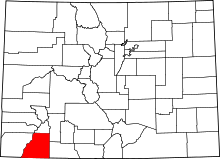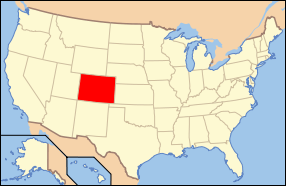La Plata County, Colorado
| La Plata County, Colorado | |
|---|---|
 Location in the U.S. state of Colorado | |
 Colorado's location in the U.S. | |
| Founded | February 10, 1874 |
| Named for | Spanish language word for silver |
| Seat | Durango |
| Largest city | Durango |
| Area | |
| • Total | 1,700 sq mi (4,403 km2) |
| • Land | 1,692 sq mi (4,382 km2) |
| • Water | 7.6 sq mi (20 km2), 0.4% |
| Population (est.) | |
| • (2015) | 54,688 |
| • Density | 30/sq mi (12/km²) |
| Congressional district | 3rd |
| Time zone | Mountain: UTC-7/-6 |
| Website |
co |
La Plata County is one of the 64 counties in the U.S. state of Colorado. As of the 2010 census, the population was 51,334.[1] The county seat is Durango.[2] The county was named for the La Plata River and the La Plata Mountains. "La plata" is the Spanish language word for "silver".
La Plata County comprises the Durango, CO Micropolitan Statistical Area.[3][4]
The county is home to Durango Rock Shelters Archeology Site, the type site for the Basketmaker II period of Anasazi culture.
Geography
According to the U.S. Census Bureau, the county has a total area of 1,700 square miles (4,400 km2), of which 1,692 square miles (4,380 km2) is land and 7.6 square miles (20 km2) (0.4%) is water.[5]
Adjacent counties
- San Juan County - north
- Hinsdale County - northeast
- Archuleta County - east
- San Juan County, New Mexico - south
- Montezuma County - west
- Dolores County - northwest
Demographics
| Historical population | |||
|---|---|---|---|
| Census | Pop. | %± | |
| 1880 | 1,110 | — | |
| 1890 | 5,509 | 396.3% | |
| 1900 | 7,016 | 27.4% | |
| 1910 | 10,812 | 54.1% | |
| 1920 | 11,218 | 3.8% | |
| 1930 | 12,975 | 15.7% | |
| 1940 | 15,494 | 19.4% | |
| 1950 | 14,880 | −4.0% | |
| 1960 | 19,225 | 29.2% | |
| 1970 | 19,199 | −0.1% | |
| 1980 | 27,424 | 42.8% | |
| 1990 | 32,284 | 17.7% | |
| 2000 | 43,941 | 36.1% | |
| 2010 | 51,334 | 16.8% | |
| Est. 2015 | 54,688 | [6] | 6.5% |
| U.S. Decennial Census[7] 1790-1960[8] 1900-1990[9] 1990-2000[10] 2010-2015[1] | |||
As of the census[11] of 2000, there are 43,941 people in the county, organized into 17,342 households and 10,890 families. The population density is 26 people per square mile (10/km²). There are 20,765 housing units at an average density of 12 per square mile (5/km²). The racial makeup of the county is 87.31% White, 5.78% Native American, 0.40% Asian, 0.31% Black or African American, 0.05% Pacific Islander, 3.90% from other races, and 2.25% from two or more races. 10.40% of the population are Hispanic or Latino of any race.
There are 17,342 households out of which 29.60% have children under the age of 18 living with them, 49.90% are married couples living together, 8.70% have a female householder with no husband present, and 37.20% are non-families. 24.80% of all households are made up of individuals and 6.10% have someone living alone who is 65 years of age or older. The average household size is 2.43 and the average family size is 2.92.
In the county the population is spread out with 22.70% under the age of 18, 13.90% from 18 to 24, 29.00% from 25 to 44, 25.10% from 45 to 64, and 9.40% who are 65 years of age or older. The median age is 36 years. For every 100 females there are 103.60 males. For every 100 females age 18 and over, there are 103.10 males.
The median income for a household in the county is $40,159, and the median income for a family is $50,446. Males have a median income of $32,486 versus $24,666 for females. The per capita income for the county is $21,534. 11.70% of the population and 6.70% of families are below the poverty line. Out of the total population, 9.30% of those under the age of 18 and 7.70% of those 65 and older are living below the poverty line.
Communities
City
Towns
Unincorporated communities
Ghost towns
- Greysill Mines
- La Plata
- Parrott City[12]
Recreation
National forest and wilderness
National historic district
Trails
Bicycle route
Scenic byway
See also
- Outline of Colorado
- Index of Colorado-related articles
- Colorado census statistical areas
- Durango Micropolitan Statistical Area
- National Register of Historic Places listings in La Plata County, Colorado
References
- 1 2 "State & County QuickFacts". United States Census Bureau. Retrieved June 8, 2014.
- ↑ "Find a County". National Association of Counties. Retrieved 2011-06-07.
- ↑ "OMB Bulletin No. 10-02: Update of Statistical Area Definitions and Guidance on Their Uses" (PDF). United States Office of Management and Budget. December 1, 2009. Retrieved April 19, 2012.
- ↑ See the Colorado census statistical areas.
- ↑ "US Gazetteer files: 2010, 2000, and 1990". United States Census Bureau. 2011-02-12. Retrieved 2011-04-23.
- ↑ "County Totals Dataset: Population, Population Change and Estimated Components of Population Change: April 1, 2010 to July 1, 2015". Retrieved July 2, 2016.
- ↑ "U.S. Decennial Census". United States Census Bureau. Retrieved June 8, 2014.
- ↑ "Historical Census Browser". University of Virginia Library. Retrieved June 8, 2014.
- ↑ "Population of Counties by Decennial Census: 1900 to 1990". United States Census Bureau. Retrieved June 8, 2014.
- ↑ "Census 2000 PHC-T-4. Ranking Tables for Counties: 1990 and 2000" (PDF). United States Census Bureau. Retrieved June 8, 2014.
- ↑ "American FactFinder". United States Census Bureau. Retrieved 2011-05-14.
- ↑ Parrott
External links
- La Plata County Government website
- La Plata County State Register properties
- Colorado County Evolution by Don Stanwyck
- Colorado Historical Society
- La Plata County Central Reservations
- Access Durango, Colorado Community Portal
 |
Dolores County | San Juan County | Hinsdale County |  |
| Montezuma County | |
Archuleta County | ||
| ||||
| | ||||
| San Juan County, New Mexico |
Coordinates: 37°17′N 107°51′W / 37.29°N 107.85°W
